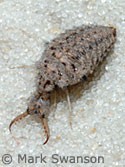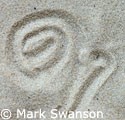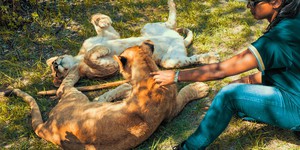Abstract
Antlion larvae are known for their predatory ways. In sandy areas, they dig pits to trap ants or other crawling insects that happen to stumble in. This project shows you how to create a mini-environment for antlion larvae to test their preferences for pit-building sites.Summary
Andrew Olson, Ph.D., Science Buddies
Sources
This project is based on:
- Boland, M. J., 2004. Antlion Natural History, California State Science Fair Abstract. Retrieved August 1, 2006.
Objective
The goal of this project is to determine whether antlions prefer to build their pits in open sand or in sand under leaf litter.
Introduction
Antlions (also called doodlebugs) are insect larva that prey on other insects. They dig funnel-shaped traps in sand or soil, and lie in wait at the bottom for victims to stumble in. When an insect tumbles down the loose sand, the waiting antlion grabs it in its mandibles and devours its prey.
It's interesting to watch an antlion dig its trap. You can even see a video at the Antlion Pit website (Swanson, 2006). They can snap their bodies to throw sand, and can dig a trap in about fifteen minutes. They also make interesting tracks ("doodles") in the sand as they search for a suitable location.
When the larva has grown big enough, it pupates. It builds a cocoon around itself, and develops into an adult. When the adult emerges, weeks later, it seeks something to climb, and waits as its wings harden. Later, the females will mate with males, and then lay their eggs in the sand, starting the life cycle over again.
How does an antlion larva choose a site in which to dig its trap? Do they prefer open sand over sand covered with leaf litter? You can find out by building an artificial antlion habitat with equal areas of each type. Release the antlions in the center and examine where they end up. Do they show a preference for a certain type of habitat? Try to think of other variables you could test with this setup.
Terms and Concepts
To do this project, you should do research that enables you to understand the following terms and concepts:
- antlion,
- habitat,
- larva,
- pupa.
Questions
- How long do antlions typically remain in the larval stage?
- What do antlion larvae eat?
- How long does metamorphosis take?
- How long do antlion adults survive?
Bibliography
- This site has lots of information on antlions (including QuickTime videos!):
Swanson, M., 2006. The Antlion Pit—A Doodlebug Anthology,. Retrieved August 1, 2006. - This site has pictures of antlions:
Wikipedia Contributors, 2009. Antlion, Wikipedia: The Free Encyclopedia. Retrieved April 29, 2009.
Materials and Equipment
To do this experiment you will need the following materials and equipment:
- antlion larvae:
- can be collected from their natural habitat, or,
- can be ordered online:
http://www.antlionfarms.com/antlions_for_education
- sand or soil (preferably collected from antlion's natural habitat);
- leaf litter (preferably collected from antlion's natural habitat);
- shallow pan;
- ants or other small, crawling insects (to feed antlions).
Disclaimer: Science Buddies participates in affiliate programs with Home Science Tools, Amazon.com, Carolina Biological, and Jameco Electronics. Proceeds from the affiliate programs help support Science Buddies, a 501(c)(3) public charity, and keep our resources free for everyone. Our top priority is student learning. If you have any comments (positive or negative) related to purchases you've made for science projects from recommendations on our site, please let us know. Write to us at scibuddy@sciencebuddies.org.
Experimental Procedure
- If you want to collect antlions yourself, they can be found "in sheltered, sandy areas such as wooded dunes, open forest floors, and dry, tree-lined river banks. They can also be found in the sandy soil of flower beds, under hedges or eaves, or in undeveloped city lots." (Swanson, 2005) Note: be sure that you have permission from the landowner before collecting (e.g., it is not OK to collect in a National Park).
- Once you have located antlion pits, here are some tips on capturing the larvae from the Antlion Pit website (Swanson, 2006):
- "With your hand, a spoon, or a small trowel, scoop out the entire pit with one steady motion, being careful to dig deep enough so as not to crush the antlion.
- "Let the sand sift through your fingers or pour it into a strainer to expose the animal. The antlion larva may be difficult to spot at first because its gray-brown color often blends in with the soil.
- "When removing an antlion in this manner you may discover the exposed antlion lying on its back, motionless, and apparently dead. However, it will soon flip over and immediately begin its backward shuffle in an attempt to bury itself once again."
- Collect sand and leaf litter for constructing an experimental antlion habitat.
- To make the experimental habitat, fill the shallow pan with sand. Cover half the pan with leaf litter and leave the other half uncovered.
- Be sure that both sides of the pan have the same temperature and lighting.
- Release the antlion larvae in the middle of the pan (at the border between open sand and leaf litter).
- After the antlion traps are established, count how many are in each zone.
- It's a good idea to observe many trials to make sure that the results are consistent. For more trials, collect the antlions from the pan, smooth out the sand, re-scatter the leaf litter and repeat the experiment.
- Is there a preference for one side or the other?
Ask an Expert
Global Connections
The United Nations Sustainable Development Goals (UNSDGs) are a blueprint to achieve a better and more sustainable future for all.
Variations
- Scientists typically try multiple approaches to test a hypothesis before accepting it. Can you think of addtional ways to test nesting site preference in antlions? The experimental method used in this project relies on captive antlions in a constructed environment. How about conducting a survey of a natural area and counting antlions found in open sand vs. under leaf cover? Be sure that the survey includes equal areas of both kinds of habitat.
- If you plan to perform the experiment with antlions that you collect yourself, here is an interesting variation you might try: consider whether antlions have an innate preference for an open vs. leaf-covered nest site. Separately collect antlions from both types of habitat (label the collection jars so you know which habitat the larvae came from), and test them in separate pans. Do antlions collected from under leaf litter ususally prefer to build their new nests under leaf litter or in open sand? How about antlions collected in open sand?
- Design an experiment to test if leaf cover or temperature is a more important determinant for nesting site preference for antlion larvae. You will need to design an artificial habitat in which you can warm one half while keeping the other at room temperature (e.g., don't use a metal pan, which will conduct heat to both sides). Conduct trials comparing the four choices summarized in the following table:
Side 1 Side 2 temperature surface temperature surface warm leaf litter room temp. open room temp. leaf litter warm open warm leaf litter warm open room temp. leaf litter room temp. open
Careers
If you like this project, you might enjoy exploring these related careers:











